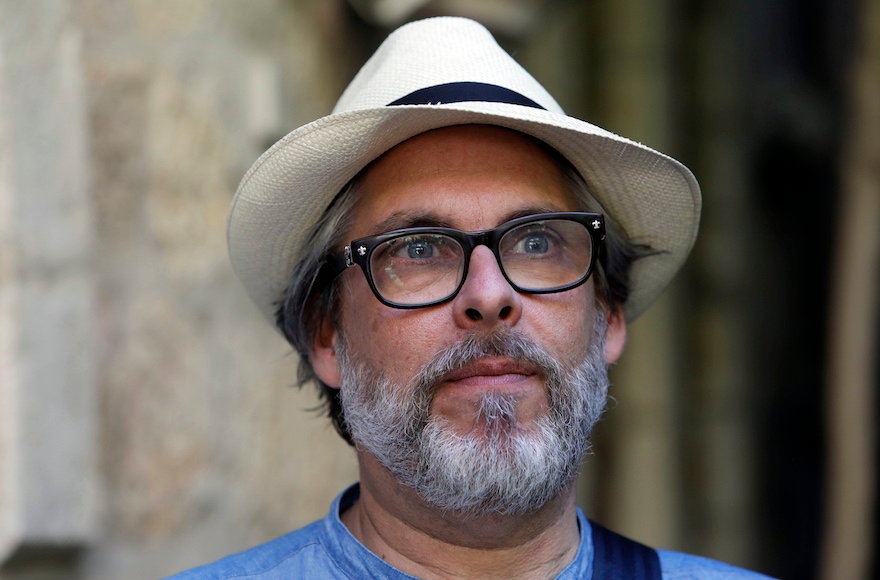Imagine there’s no countries
It isn’t hard to do
Nothing to kill or die for
And no religion, too
— John Lennon
(JTA) — On May 14, Michael Chabon gave the most remarkable commencement speech in the recent history of Hebrew Union College-Jewish Institute of Religion, the Reform movement’s highly respected flagship seminary and training institution.
Surpassing the widely held view that the intermarried, their children and their non-Jewish family members ought to be welcomed warmly by the Jewish community, Chabon took the next step — or shall we say, the next giant leap. He inveighed against inmarriage itself as a desirable aspiration, as a sacred Jewish norm and as an effective instrument of Jewish continuity.
His words bear repeating, much as it pains us to write them:
“An endogamous marriage is a ghetto of two. … It draws a circle around the married couple, inscribes them – and any eventual children who come along – within a figurative wall of tradition, custom, shared history, and a common inheritance of chromosomes and culture.”
Chabon urged the HUC-JIR graduates and their parents to abandon advocacy for Jewish-Jewish marriage, rejecting the view that Jewish homes with a single group identity are critical to raising Jewishly committed and Judaically competent children. Later he underscored the seriousness of his rejection of inmarriage by, in effect, doing “teshuvah” for having inmarried with his beloved Jewish wife and for having taught his four children that marrying Jews is the preferred option.
Apparently to accelerate Judaism’s withering away in at least one household, Chabon proudly related his recent draconian “retreat from religious practice.” Indeed, the only aspects of Jewish culture that Chabon ratified as valuable today are those related to critical thinking, such as “learning, inquiry and skepticism.”
Not content to pummel a traditional norm, Chabon targeted the heart of Judaism itself. He condemned the overarching concept of “havdalah” (the Judaic value of distinguishing between entities), which he depicted as a “giant interlocking system of distinctions and divisions.” He specifically targeted Shabbat candle-lighting, monthly immersions in the ritual bath, circumcision, bar mitzvah and the Four Questions recited during the Passover seder.
Even the Passover removal of leavened bread troubled this would-be slayer of Judaism’s age-old distinction-making ethos.
Chabon extolled the virtues of outmarriage, declaring himself a devotee of “mongrels, syncretism, integrated neighborhoods, open borders, pastiche and collage,” and, above all, “miscegenation as the source of all greatness.”
It is important to recognize that Chabon’s call to abandon inmarriage is a symbol of his larger, more grandiose objective. Promoting intermarriage was the opening shot in a drive to dismantle Judaism and put an end to the ostensibly inherent and inevitable injustices he insists religion perpetuates.
Not only is Judaism responsible for religious prejudice around the world, it is also responsible for its own demise: If Judaism disappears from the earth, Chabon asserted, “the fault for that extinction will lie squarely with Judaism itself.”
Chabon seemed content, even disturbingly relaxed, imagining the end of Judaism.
“If Judaism should ever pass from the world,” he said, “it won’t be the first time in history … that a great and ancient religion lost its hold on the moral imaginations of is adherents.”
What are we to say?
It is tempting to dismiss Chabon’s thinking as hyperbolic, idiosyncratic or unworthy of reply, perhaps performance art of a personal psychodrama in a public setting. But Chabon’s undeniable and sometimes dazzling talent as a novelist and the high status he enjoys among elite reading audiences make it critical to respond.
Even more important, his perspectives have unfortunately been foreshadowed and echoed in other corners of the Jewish community. Chabon’s ideas have cache, especially in culturally and political progressive bubbles, such as elite universities where Jews live in safe enclaves, experiencing highly privileged lives.
In fact, Chabon’s willfully ignorant denial of intermarriage as a threat to the health of American Jewish life is common in many Jewish circles outside of certain subgroups, among them Orthodoxy, religious Conservative Jews, political conservatives and Jewish immigrant communities. (Only one-fifth of recently marrying Jews raised in Reform families married other Jews.)
Citing the fact that intermarried couples are proud to identify as Jews, the majority of American liberal Jews ignore the mountain of evidence that only a small minority of those adult children raised by intermarried parents remain firmly connected to Judaism, Jewish friends, community or culture. Only 8 percent of the grandchildren of the intermarried are being raised in the Jewish religion. Few intermarried households are anywhere near as educated, connected or committed as their single-ancestry contemporaries. Among the 7 million or so American adults who have been raised by a Jewish parent, over 2 million deny they are Jewish.
Chabon’s views are worrisome because among liberal American Jews they are not so outlandish. We live in an age that not only is opposed to behavioral norms imposed from above but to social boundaries to our left and right. Jews, a tiny minority in a sea of over 300 million Americans, are being engulfed increasingly by the majority society — one blessed by a deep culture of welcoming and tolerance, at least until recently.
Theologically and ideologically, our concept of peoplehood requires both respect for the outside culture, but also transmitting our own. Distinguishing between Jews and non-Jews has made Jewish societies more tolerant, since according to Judaism only Jews are called upon to comply with Judaic law.
Once, some argued that intermarriage was inevitable in an open society and trying to prevent it was as futile as trying to resist gravity or change the weather. Chabon and people who share his values now go a step further: They like the new weather. They view intermarriage as a positive development in human history, not a step toward Jewish self-destruction.
Chabon’s assault on the positive salience of Jewish difference is dangerous, morally abhorrent and factually incorrect on at least four verifiable counts.
First, Judaism as a religious culture offers so much more of value than critical thinking skills alone. To take just one example, albeit an outstanding one: Ancient Judaism, unique among world cultures, introduced the very inclusive weekly day of rest, the Sabbath, and mandated it for all socio-economic classes, without exception. The Sabbath was a bold blow against what Chabon calls “the economics of exclusion.” Recognizing its virtue, Christianity and Islam adopted the Sabbath concept from Judaism.
Millions of Jews cherish the cultural richness that the celebration of the Jewish calendar year brings to their lives and the lives of their children — as Chabon and his family did until recently. Millions are captivated by the intellectual wealth, moral wisdom and cultural complexity of Judaic text study. For others, the warmth of Jewish community life is the compelling factor. Still others demand social justice in the name of Judaism, putting the directives of the Hebrew prophets into practice in local and international settings.
Not least, for many American Jews the opportunity to engage with Israel, the only country in the world where the language, culture and religious ethos are Jewish, is a source of joy and renewal.
Second, Chabon treated religious extremism as a Jewish monopoly. But worldwide — including the United States — large swathes of society have reacted to transnational change by retreating into sectarian and exclusivist ethnoreligious and political enclaves. Yet Chabon declared that he would be fine with his children marrying into other religions that are as likely to produce exponents of intolerance and extremism as the Jews who provoke Chabon’s fear and disgust.
Third, distinctiveness is not the enemy of creativity. Chabon’s rhetorical rejection of making distinctions is revealed as a lie in his own justly acclaimed novels. Chabon’s gorgeous, edgy, evocative language is the product of the author making artistic “distinction and divisions,” moving sentences from one paragraph to another. As Chabon well knows, only when artists define their own “boundaries and bright lines” can they create credible settings, provide each character with distinctive dialogue, and give each character life and dimension on the page.
Indeed, much of Chabon’s commencement address was curiously binary and judgmental — and bogus. We can all, like Chabon, love “pastiche and collage,” but distinctions are necessary to life and health, judgment and morality – to say nothing about science, families, communities and nations.
Finally, religious “syncretism,” which Chabon embraced, erodes ethnoreligious viability. Sociologists and historians provide powerful evidence of rich minority cultures that fade not because of their moral “fault,” as Chabon asserts, but because they could not maintain their distinctiveness and cohesion. Minority cultures may not need to be hermetically sealed off, but to survive they all depend on living expression in the form of ethnic languages, music, arts, foods, texts, history, religion and folkways.
Marriages between two Jews, whether born Jews or Jews by choice, along with Jewish societies that support them, are demonstrably the most effective factors in Jewish vitality because they do indeed create a “figurative wall of tradition, custom, shared history and a common inheritance” — and, contrary to Chabon, that is a good thing. To deny this reality is to deny sociologically verifiable facts. Chabon may no longer care — but we still do.
Chabon naively envisions a utopian world where through wholesale intermarriage of all races, nationalities and creeds, all of humanity will be homogenized into a single “mongrelized” blandness. In practice, since Jews are a minuscule minority worldwide, this prescription would yield the disappearance of Diaspora Jews and Judaism. Christian denominations would be untouched. Buddhism, Hinduism and Islam would be unperturbed. The world with all its divisiveness would hardly notice — but it would be a world without Jews.
Jews with any historical sense have seen this movie before. At least since the Enlightenment, some Jewish cultural elites have proposed that the solution to the world’s ills is Jewish assimilation. If only the Jews would let go of their distinctive religious culture, the world would be redeemed.
Over the past four decades and more, the Jewish community has been marked by impassioned discourse over intermarriage. Though far from uniform, a “left” camp has argued for greater acceptance, welcoming and inclusion of the intermarried and their family members. The Jewish “right” has argued for holding on to distinctions – liturgical and otherwise – between the inmarried and the intermarried.
Each camp sees the other as suspect, albeit in very different ways. Those on the left don’t believe the right is sincerely committed to tolerance and welcoming. To those on the right, the left’s promotion of “welcoming” has seemed like a stalking horse for total indifference to intermarriage, if not the celebration of intermarriage.
We urge the proponents of welcoming and inclusion – many of whom we count as dear friends and colleagues — to think anew about where they stand in regard to Chabon’s challenge. Where would you draw boundaries? Where do you stand on maintaining some distinctions between Jews and others? Is Jewish group survival a force for good or for ill, not only for individual Jews but for humanity? Should we teach the next generation that all Jews —both those born Jewish and converts — are in a kinship relationship with one another as heirs of a unique, rich and valuable cultural heritage?
As Pete Seeger once asked, “Which side are you on? Which side are you on?”
(Sylvia Barack Fishman is the Joseph and Esther Foster Professor of Contemporary Jewish Life in the Near Eastern and Judaic Studies Department at Brandeis University. Steven M. Cohen is Research Professor of Jewish Social Policy at HUC-JIR, and director of the Berman Jewish Policy Archive. Jack Wertheimer is the Joseph and Martha Mendelson Professor of American Jewish History at the Jewish Theological Seminary.)
RELATED:
‘Radical inclusion’ of interfaith families is the best response to Michael Chabon
JTA has documented Jewish history in real-time for over a century. Keep our journalism strong by joining us in supporting independent, award-winning reporting.






